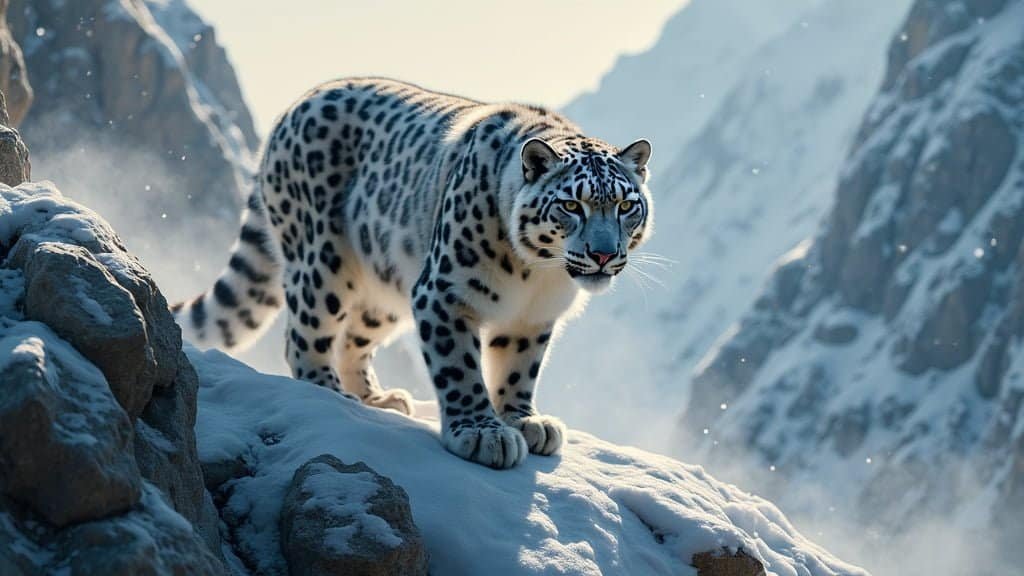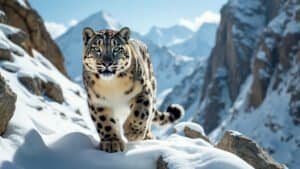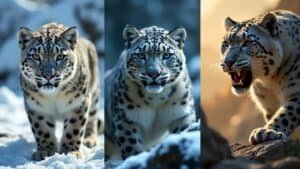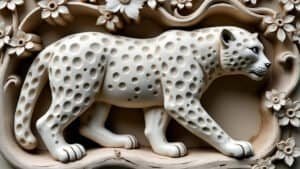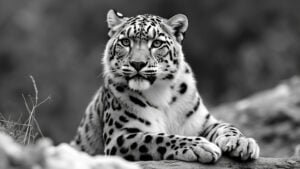Introduction
Snow leopards have long captured the human imagination, inspiring awe and reverence across various cultures. In folklore and mythology, these elusive creatures are often depicted as powerful symbols of mysticism, strength, and spirituality
From the towering peaks of the Himalayas to the vast steppes of Central Asia, snow leopards appear in tales, spiritual beliefs, and even modern media, carrying deep cultural significance
This article explores the myriad ways snow leopards have been represented in different traditions, their sacred roles, and how these majestic animals continue to inspire stories and art today
Overview of Snow Leopards in Folklore and Mythology
Snow leopards, often referred to as “mountain ghosts” due to their elusive nature, have been embedded in the folklore and mythology of various cultures, particularly in the regions where they are native
These powerful predators are native to the rugged mountainous regions of Central and South Asia, where they have been revered and feared in equal measure. In many of these cultures, snow leopards symbolize strength, solitude, and mysticism, often appearing in tales that reflect the harsh and mysterious environments they inhabit
Traditional Symbolism in Himalayan Cultures
In the high-altitude regions of the Himalayas, snow leopards hold a special place in local folklore. They are often considered guardians of the mountains, representing the untamed and wild spirit of nature
The people of the Himalayas, including the Sherpas and Tibetan communities, believe that snow leopards possess supernatural abilities. These abilities include the power to protect against evil spirits and to bring good fortune to those who respect them
For instance, in Bhutanese folklore, snow leopards are seen as the protectors of sacred mountain passes. It is believed that encountering a snow leopard while traveling through these areas is a sign of divine protection
Additionally, the animal is often linked to deities associated with the natural world, reinforcing its status as a spiritual being rather than just a wild animal
Snow Leopards in Tibetan Buddhism
In Tibetan Buddhism, snow leopards are revered as symbols of courage and the ability to overcome obstacles. The animal’s solitary nature and its ability to survive in the harshest of environments make it an emblem of resilience and self-reliance
In some Buddhist teachings, the snow leopard is considered a manifestation of the deity Milarepa, a Tibetan yogi known for his deep spiritual insight and connection to the natural world
The connection between snow leopards and Milarepa is particularly significant because Milarepa is one of the most beloved figures in Tibetan Buddhism
His life story, which involves a long period of solitude and meditation in the mountains, mirrors the solitary life of the snow leopard. This association elevates the snow leopard from a mere animal to a symbol of spiritual enlightenment
Representations in Central Asian Myths
In Central Asian mythology, snow leopards are often depicted as powerful and mysterious beings that possess both physical strength and mystical powers. For the nomadic tribes of Central Asia, the snow leopard represents the ideal hunter, capable of navigating treacherous landscapes with ease and precision
This perception is deeply rooted in the survivalist ethos of these communities, where hunting was not only a means of sustenance but also a test of skill and endurance
One of the most well-known tales from this region is the story of the “Ghost Cat,” a snow leopard believed to have the ability to disappear into thin air, making it impossible for hunters to capture or even see it
This myth reinforces the idea of the snow leopard as an elusive and otherworldly creature, one that exists on the border between the natural and the supernatural
In some Central Asian shamanic traditions, snow leopards are also believed to be spiritual guides, capable of leading shamans on journeys to other realms. This belief underscores the deep spiritual connection that these cultures have with the animal, viewing it as a bridge between the human world and the spiritual domain
Cultural Symbols Associated with Snow Leopards
Snow leopards are not just majestic animals of the mountains; they are deeply ingrained in the cultural symbolism of various communities across Asia
Their representation as cultural symbols reflects their status as both revered and feared creatures, embodying qualities such as strength, mystery, and resilience. This symbolic significance can be seen in the traditions, religious practices, and artistic expressions of the people who share their habitats with these elusive cats
Traditional Symbolism in Himalayan Cultures
In the cultures of the Himalayan region, the snow leopard is often seen as a symbol of the natural and supernatural world. The animal’s ability to move silently through the snowy landscapes, combined with its rare sightings, has given rise to the belief that snow leopards are spiritual beings
In many Himalayan communities, snow leopards are thought to be protectors of the mountains, ensuring the balance between the natural elements and the human world
For instance, in Nepalese culture, the snow leopard is often linked with the concept of “jhakri,” a shamanic figure who is believed to have the power to communicate with spirits and the natural world
Snow leopards are sometimes considered to be the spirit animals of jhakris, guiding them in their spiritual journeys and helping them navigate the mystical aspects of the world. This connection between the snow leopard and shamanic practices underscores the deep respect and reverence the local people have for this animal
In Ladakh, India, snow leopards are often featured in local art and textiles, symbolizing power and grace. The animal’s image is used in various forms of traditional craftsmanship, from woven carpets to carved wooden items, reflecting its importance in the cultural and spiritual life of the region
Snow Leopards in Tibetan Buddhism
In Tibetan Buddhism, snow leopards hold a unique place as symbols of meditation and inner strength. Their solitary nature and ability to survive in extreme conditions make them powerful symbols of self-reliance and perseverance
Tibetan monks often view the snow leopard as a metaphor for the disciplined mind, capable of navigating the challenging landscape of spiritual practice with quiet strength and determination
Snow leopards are also associated with certain deities in Tibetan Buddhism, particularly those linked to the mountains and wilderness. The association with these deities further elevates the snow leopard to a divine status, reinforcing its role as a spiritual guardian of the highlands
In some Buddhist iconography, the snow leopard is depicted alongside other sacred animals, representing the harmony and balance of nature
Furthermore, the animal’s elusive nature is seen as a reminder of the impermanence of life and the importance of living with mindfulness and awareness. The snow leopard’s ability to blend into its environment and remain unseen parallels the Buddhist concept of the illusory nature of the material world, encouraging practitioners to seek deeper truths beyond the surface
Representations in Central Asian Myths
In Central Asia, snow leopards are often depicted as symbols of power, freedom, and mystery. Their ability to thrive in the harsh, rugged landscapes of the region has made them a symbol of endurance and adaptability
For the nomadic tribes of Central Asia, snow leopards represent the ultimate hunter, embodying the skills and instincts needed to survive in the wild
The snow leopard’s role in Central Asian myths is often intertwined with the region’s shamanic traditions. Shamans in these cultures view the snow leopard as a totem animal, representing the connection between the physical world and the spiritual realm
The animal’s ability to move silently and swiftly through the mountains is seen as a sign of its otherworldly powers, making it a revered figure in rituals and ceremonies
One prominent myth from Kazakhstan tells of a snow leopard that guards a sacred mountain, protecting it from those who would desecrate the land. This story reflects the deep respect that the people of Central Asia have for the snow leopard, seeing it as a guardian of nature and a symbol of the untamed wilderness
In modern times, the snow leopard has also become a national symbol in some Central Asian countries, representing the pride and heritage of the region. For example, the snow leopard is featured on the emblem of Kazakhstan, symbolizing the strength and resilience of the nation
Sacred and Spiritual Roles of Snow Leopards
Snow leopards have been regarded as sacred animals in various cultures, often linked with spiritual practices and religious beliefs. Their mystical presence in the mountains, combined with their rare and elusive nature, has led to their reverence as powerful spiritual symbols
Across different regions, snow leopards have been imbued with meanings that go beyond their physical presence, serving as totems, protectors, and guides in the spiritual realm
The Snow Leopard as a Sacred Animal
In several cultures, snow leopards are considered sacred creatures, embodying the spirit of the wild and the mountains. The reverence for these animals is evident in the rituals and customs of the people who share their habitats
In Mongolia, for example, snow leopards are often regarded as the “Lords of the Mountains.” This title reflects their status as supreme beings within the natural order, holding dominion over the harsh, rugged terrains they inhabit
Mongolian shamans believe that snow leopards possess the power to connect the human world with the spirit world. As sacred animals, they are thought to carry the prayers of the people to the spirits of the mountains, acting as intermediaries between the physical and spiritual realms
This belief is particularly strong in the Altai Mountains, where snow leopards are seen as guardians of the sacred land, ensuring that the balance of nature is maintained
Similarly, in parts of Tibet, the snow leopard is revered as a symbol of purity and spiritual strength. Tibetan communities often associate snow leopards with sacred mountain deities, believing that these animals embody the spirits of the gods who protect the land and its people
In some areas, it is customary to perform rituals and offerings to snow leopards as a way of seeking protection and blessings from the mountain gods
Shamanic Traditions and Spiritual Meanings
Shamanic traditions in Central Asia and Siberia frequently feature the snow leopard as a powerful spiritual guide. Shamans, who serve as healers and spiritual leaders in these cultures, often seek to connect with the spirit of the snow leopard to gain insight and guidance
The animal’s attributes—its stealth, strength, and ability to navigate the treacherous mountain landscapes—are seen as qualities that can be invoked during shamanic rituals
In some Siberian cultures, the snow leopard is considered a “spirit animal” that guides shamans on their journeys between worlds. This role is critical in shamanic practices, where the snow leopard is believed to help the shaman navigate the complex spiritual landscape, offering protection and wisdom along the way
The snow leopard’s keen senses and agility are metaphorically linked to the shaman’s ability to traverse the spiritual realms and communicate with the spirits
Moreover, the snow leopard’s solitary nature is often seen as a symbol of introspection and spiritual growth. In many shamanic traditions, the snow leopard embodies the idea of the solitary quest—a journey undertaken alone, often in the wilderness, to achieve spiritual enlightenment or personal transformation
This symbolism has deep roots in the cultural narratives of the regions where snow leopards are found, reinforcing the animal’s status as a spiritual icon
Modern Spiritual Interpretations
In contemporary spiritual practices, snow leopards continue to be revered as symbols of mystery, intuition, and inner strength. With the growing interest in animal totems and spiritual symbolism, snow leopards have found a place in modern spiritual and new age practices
They are often invoked in meditation and visualization exercises, where individuals seek to connect with the qualities that snow leopards represent—such as patience, stealth, and the ability to blend into one’s surroundings
In new age spirituality, snow leopards are sometimes viewed as guides for those on a path of self-discovery and transformation. Their ability to survive and thrive in extreme conditions is seen as an inspiration for people facing challenges in their own lives
The snow leopard’s elusive nature is also symbolic of the deeper mysteries of life, encouraging individuals to explore the unknown and embrace the journey of self-exploration
Additionally, snow leopards have been adopted as symbols by various conservation and environmental groups, who view the animal not only as a species in need of protection but also as a symbol of the fragile balance between nature and human activity
This modern interpretation adds another layer to the snow leopard’s spiritual significance, linking it to broader themes of environmental stewardship and the interconnectedness of all life
Snow Leopards in Literature and Media
The enigmatic snow leopard has not only captivated the imaginations of those living in its natural habitats but has also made its mark in literature and media worldwide
These majestic creatures are often portrayed as symbols of wildness, beauty, and the mysterious forces of nature. Through various forms of storytelling—from classic literature to modern films and documentaries—snow leopards have come to represent a range of themes, from environmental conservation to personal transformation
Depictions in Classical Literature
Snow leopards have been featured in classical literature, particularly in works that explore the rugged and remote landscapes of Central Asia and the Himalayas
One of the most famous early depictions of snow leopards comes from Peter Matthiessen’s “The Snow Leopard,” a seminal work published in 1978. This book is a spiritual and ecological journey that chronicles Matthiessen’s travels through the Himalayas in search of the elusive snow leopard and his own inner peace
“The Snow Leopard” is often praised for its poetic prose and deep philosophical reflections on life, nature, and spirituality. The snow leopard in this narrative symbolizes the elusive nature of enlightenment, as well as the profound mysteries of the natural world
Matthiessen’s quest to see the snow leopard becomes a metaphor for the human search for meaning and connection with something greater than oneself
In other literary works, snow leopards are depicted as noble and mysterious creatures, often serving as metaphors for the untamed wilderness. These depictions contribute to the animal’s mythic status, reinforcing its role as a symbol of the wild and uncharted territories, both in the physical and psychological sense
Snow Leopards in Modern Literature
In modern literature, snow leopards continue to be a source of fascination and inspiration. They often appear in novels, poetry, and children’s books, where they are portrayed as majestic and mysterious animals that embody the spirit of the mountains
One example is Philip Pullman’s “His Dark Materials” series, where a snow leopard serves as the daemon (a physical manifestation of a character’s soul) of one of the main characters, symbolizing strength, stealth, and independence
Snow leopards have also featured in contemporary environmental literature, where they are used to highlight the importance of conservation and the threats facing endangered species
These works often explore the relationship between humans and nature, using the snow leopard as a focal point for discussions on environmental ethics and the impact of human activities on wildlife
In children’s literature, snow leopards are often depicted as wise and gentle creatures, guiding young protagonists on their adventures. These stories typically emphasize the snow leopard’s role as a protector of the natural world, teaching lessons about respect for nature and the importance of preserving the planet for future generations
Representations in Film and Media
Snow leopards have also made a significant impact in film and media, particularly in documentaries and wildlife programs. Their elusive nature and the challenges of filming in their remote habitats have made them a symbol of the untamed wilderness, capturing the attention of filmmakers and audiences alike
One of the most iconic documentaries featuring snow leopards is the BBC’s “Planet Earth II,” narrated by Sir David Attenborough. The series includes a breathtaking sequence that captures a snow leopard in its natural environment, offering viewers a rare glimpse into the life of this secretive predator
The footage, which took years to capture, showcases the snow leopard’s agility, strength, and ability to survive in some of the most extreme conditions on Earth. This documentary not only raised awareness about the species but also highlighted the importance of preserving their habitats
Snow leopards have also appeared in fictional films and animated movies, often depicted as noble and wise characters. In the 2008 animated film “Kung Fu Panda,” for example, the villain Tai Lung is a snow leopard, representing the formidable and powerful aspects of the animal
Although Tai Lung is portrayed as a villain, his character also embodies the snow leopard’s strength and agility, traits that are admired and respected
In addition to films, snow leopards are frequently featured in media campaigns by conservation organizations. These campaigns often use the image of the snow leopard to draw attention to the species’ endangered status and the need for international efforts to protect their habitats
The snow leopard’s striking appearance and status as a symbol of wilderness make it an ideal ambassador for conservation causes
Conclusion
Snow leopards have long been woven into the cultural and spiritual fabric of the regions they inhabit. Their portrayal in folklore and mythology reflects the deep respect and reverence that these majestic creatures command
From being seen as sacred animals and spiritual guides in Himalayan and Central Asian traditions to their symbolic roles in literature and modern media, snow leopards embody the mysteries and challenges of the wild
These representations not only highlight the snow leopard’s importance in cultural narratives but also underscore the broader themes of resilience, spirituality, and the delicate balance between humans and nature. As these elusive cats continue to inspire awe and admiration across the globe, their stories remind us of the enduring connection between the natural world and human imagination
